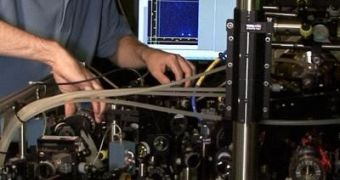Scientists at the US National Institute of Standards and Technology (NIST) announce the development of the first 'universal' programmable quantum information processor, which uses two quantum bits (qubits) of information. According to the team behind the groundbreaking achievement, the processor can be employed to run any program allowed by quantum mechanics. The demonstration paves the way for the development of advanced quantum computers, which may be used to solve problems that are currently unbreakable, due to limitations posed by existing computer technologies.
“This is the first time anyone has demonstrated a programmable quantum processor for more than one qubit. It's a step toward the big goal of doing calculations with lots and lots of qubits. The idea is you'd have lots of these processors, and you'd link them together,” the first author of the new study, NIST postdoctoral researcher David Hanneke, explains. Details of the investigation appear in the latest issue of the respected scientific journal Nature Physics. The accomplishment comes on the heels of other studies, conducted at NIST and elsewhere, which demonstrated individual tasks for quantum processors.
The new binary processor is made up of two beryllium ions (atoms with an electrical charge), which are held together by an electromagnetic field. Control is exercised with two ultraviolet lasers, and the data is stored as rows of 1s and 0s in the processor. In order to cool the beryllium ions to the super-low temperatures they need to function, the NIST team “enlisted” the help of two magnesium ions. In a true quantum-physics manner, the Institute team was also able to place the beryllium ions in a state of “superposition,” which allowed the components to carry both the values 1 and 0 at the same time.
Across the 900 test runs the processor was subjected to, each of the possible programs operated accurately in 79 percent of the cases, with an average run time of about 37 milliseconds. This is a major advancement from previous quantum processors, which could only function for a few nanoseconds. The results of the processed programs were then cross-referenced to idealized, theoretical results, in order to put things into perspective. The NIST group also identified a problem. When many successive operations were conducted, errors built up in the system. Therefore, in future qubits, this aspect will need to be corrected.

 14 DAY TRIAL //
14 DAY TRIAL //